The primary aim of the TCV experiment was to investigate the effects of plasma shape on Tokamak physics that is to study the confinement and transport properties vs. plasma elongation, triangularity and squareness. Development in plasma control, heating (powerful ECH system) and diagnostic tools has allowed investigating transport phenomena in L-mode and improved confinement regimes (H-mode and eITBs), as well as confinement control by local EC heating. The installation of a Diagnostic Neutral Beam injector (DNB) and development of the Charge eXchange Recombination Spectroscopy (CXRS) diagnostic has lead to systematical studies on plasma rotation.
Recent experimental studies on TCV help in understanding:
- Global and local energy confinement and transport in Tokamak plasmasunder various configurations
- Transport (diffusion and pinch) of main ion species (Deuterium, Hydrogen, Helium) and impurities (Carbon, Argon, etc.).
- Toroidal and poloidal rotation generation, momentum transport and their influence on plasma stability and confinement.
Rotation and momentum transport
Motivation
- Plasma rotation plays a key role in regulating turbulence and has a beneficial effect on energy confinement in fusion devices through E×B shearing.
- A strong coupling of ion heat and momentum transport has been verified by experimental observations on momentum transport (performed using Neutral Beam Heating which exerts a large torque on the plasma on different Tokamaks) and theoretical investigations into anomalous transport. It was inferred that without external input, the plasma rotation would be negligible.
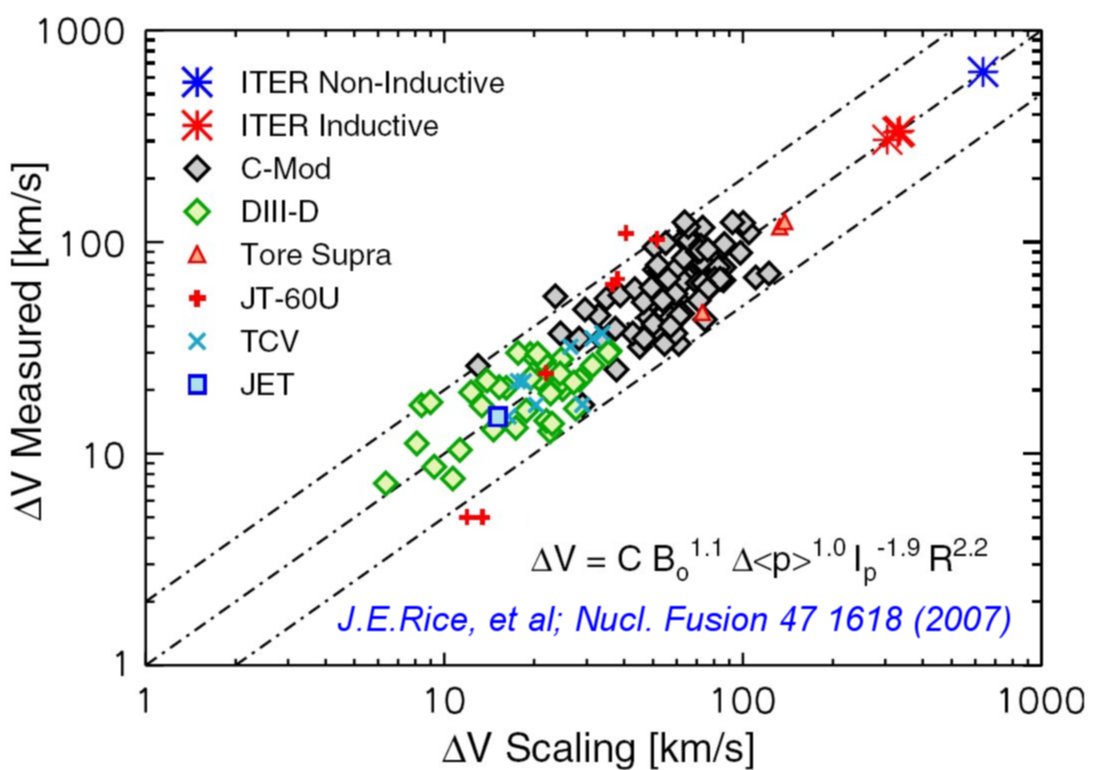
- The discovery of the intrinsic rotation, i.e. the finite rotation a plasma develops without an external toroidal torque radically changed the former picture. Experiments were done on TCV where toroidal momentum injection by low power diagnostic neutral beam is negligible (inducing toroidal rotation <1km/s).
- The intrinsic rotation is of particular interest to a reactor plasma for which the external torque will be small. Subsequently, mechanisms of toroidal momentum transport have attracted much recent attention in the Tokamak community, leading to a very rapid development in theory and modeling.
References
- Peeters A.G., et al; Overview of toroidal momentum transport; Nucl. Fusion 51 094027 (2011); DOI:10.1088/0029-5515/51/9/094027
- J.E.Rice, et al; Inter-machine comparison of intrinsic toroidal rotation in tokamaks; Nucl. Fusion 47 1618 (2007); DOI:10.1088/0029-5515/47/11/025
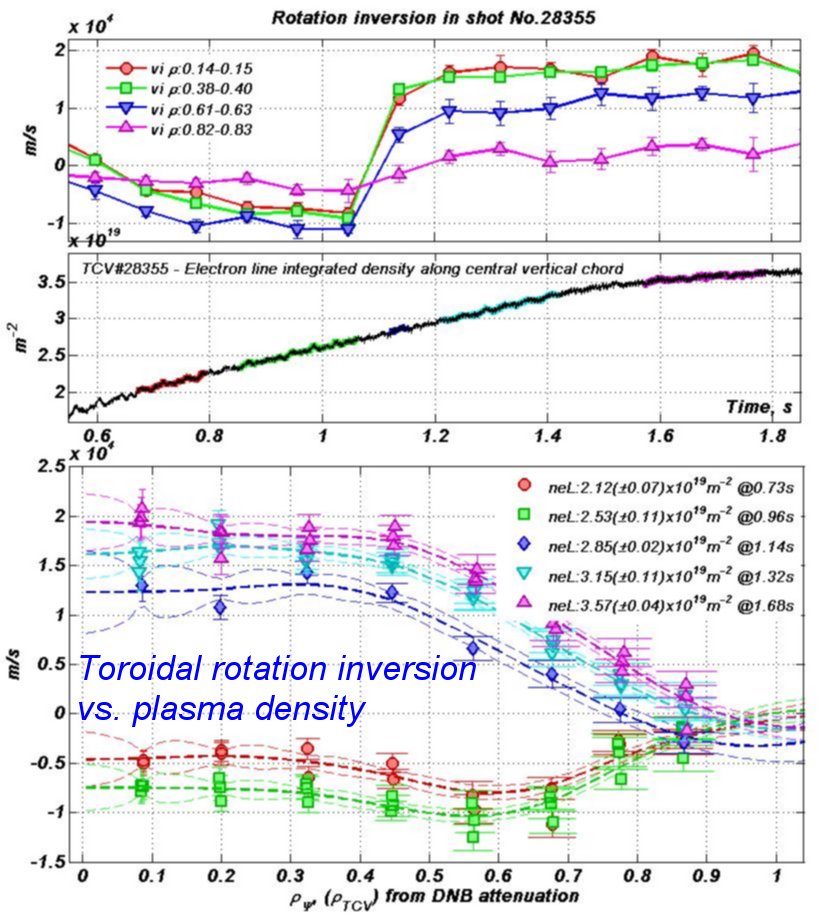 Main Results
Main Results
- Spontaneous toroidal momentum generation is systematically observed, with strong dependencies of the magnitude and sign on plasma density, boundary topology (limited or diverted), and plasma current.
- A particularly striking event is the rotation reversal that was observed in the plasma core:
- From counter- to co-current direction in limited plasmas when density is increased as well as when the edge safety factor varies.
- An opposite reversal from co- to counter-current rotation was seen in diverted plasmas.
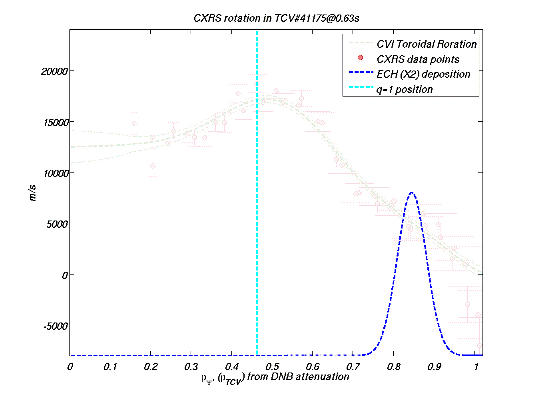
- In view of the frequent appearance of MHD modes in TCV, a dedicated effort has now been devoted in elucidating the role of MHD activity in the rotation reversal.
- Core tearing modes with low-order rational mode numbers (m/n = 2/1, 3/2) are found to strongly influence the toroidal rotation velocity profile, flattening the gradient and even reversing its sign.
- The question of the generation of spontaneous rotation is inextricably linked to that of momentum transport, and particularly turbulent transport, which is thought to play a major role.
- One mechanism of rotation generation that has recently been predicted relies on up–down plasma asymmetry and has been recently put to the test on the TCV Tokamak, whose extreme shaping capabilities are uniquely suited to this scenario.
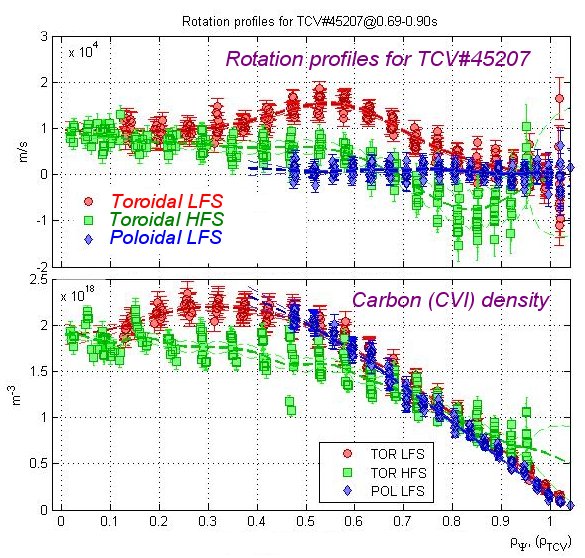 Recent activity on rotation and momentum transport are focused on:
Recent activity on rotation and momentum transport are focused on:
- Enhanced study of rotation in H-modes, so far just the L-modes have been studied in detail.
- Validation of the indirect poloidal flow measurements technique (from CXRS LFS and HFS observation) against the direct measurement (vertical poloidal lines of sight) and comparison to neoclassical theory predictions.
- Characterization of the influence of toroidal rotation and plasma current profile on the heat and particle transport.
- Study the formation and sustainment of eITBs while measuring toroidal and poloidal rotation, assess if ExB shearing is essential or not for eITBs and under what conditions.
References
- Sauter O. et al; Effects of ECH/ECCD on Tearing Modes in TCV and Link to Rotation Profile; 2010 Proc. 23rd Int. Conf. on Fusion Energy 2010 (Daejeon, South Korea 2010) (Vienna: IAEA) CD-ROM file EXS/P2-17
- Y.Camenen, A.Bortolon, B.P.Duval, L.Federspiel, A.G.Peeters, F.J.Casson, W.A.Hornsby, A.N.Karpushov, F.Piras, O.Sauter, A.P.Snodin, G.Szepesi and the TCV Team; Experimental demonstration of an up-down asymmetry effect on intrinsic rotation in the TCV tokamak, Plasma Phys. Control. Fusion 52 124037 (2010); DOI:10.1088/0741-3335/52/12/124037
- B.P.Duval, A.Bortolon, A.Karpushov, R.A.Pitts, A.Pochelon, O.Sauter, A.Scarabosio, and G.Turri; Spontaneous L-mode plasma rotation scaling in the TCV tokamak; Phys. Plasmas 15, 056113 (2008); DOI:10.1063/1.2841528
- B.P.Duval, A.Bortolon, A.Karpushov, R.A.Pitts, A.Pochelon, A.Scarabosio and the TCV Team; Bulk plasma rotation in the TCV tokamak in the absence of external momentum input; Plasma Phys. Control. Fusion 49 B195 (2007); DOI:10.1088/0741-3335/49/12B/S18
- A.Bortolon, B.P.Duval, A.Pochelon, and A.Scarabosio; Observation of Spontaneous Toroidal Rotation Inversion in Ohmically Heated Tokamak Plasmas; Phys. Rev. Lett. 97, 235003 (2006); DOI:10.1103/PhysRevLett.97.235003
- A.Bortolon, B.P.Duval, A.Pochelon, and A.Scarabosio; Observation of Spontaneous Toroidal Rotation Inversion in Ohmically Heated Tokamak Plasmas; Phys. Rev. Lett. 97, 235003 (2006); DOI:10.1103/PhysRevLett.97.235003
PhD theses
- A.Bortolon, B.Duval (Dir.); Plasma rotation and momentum transport studies in the TCV tokamak based on charge exchange spectroscopy measurements; EPFL, Lausanne, 2009. DOI:10.5075/epfl-thesis-4569
- A.Scarabosio, A.Pochelon and B.Duval (Dirs.); Stability and toroidal rotation properties of highly shaped plasmas in the TCV tokamak; EPFL, Lausanne, 2006. DOI:10.5075/epfl-thesis-3609
- P.Bosshard, B.Duval (Dir.); Confinement ionique dans le tokamak TCV mesuré par spectroscopie d’échange de charge. EPFL, Lausanne, 2003. doi:10.5075/epfl-thesis-4569
Key group members
International collaborations
- Yann Camenen National Center for Scientific Research, Aix-Marseille University, France
- Alessandro Bortolon Department of Physics and Astronomy, University of California & Princeton Plasma Physics Laboratory, US
Energy confinement and particle transport
Main TCV results on plasma transport
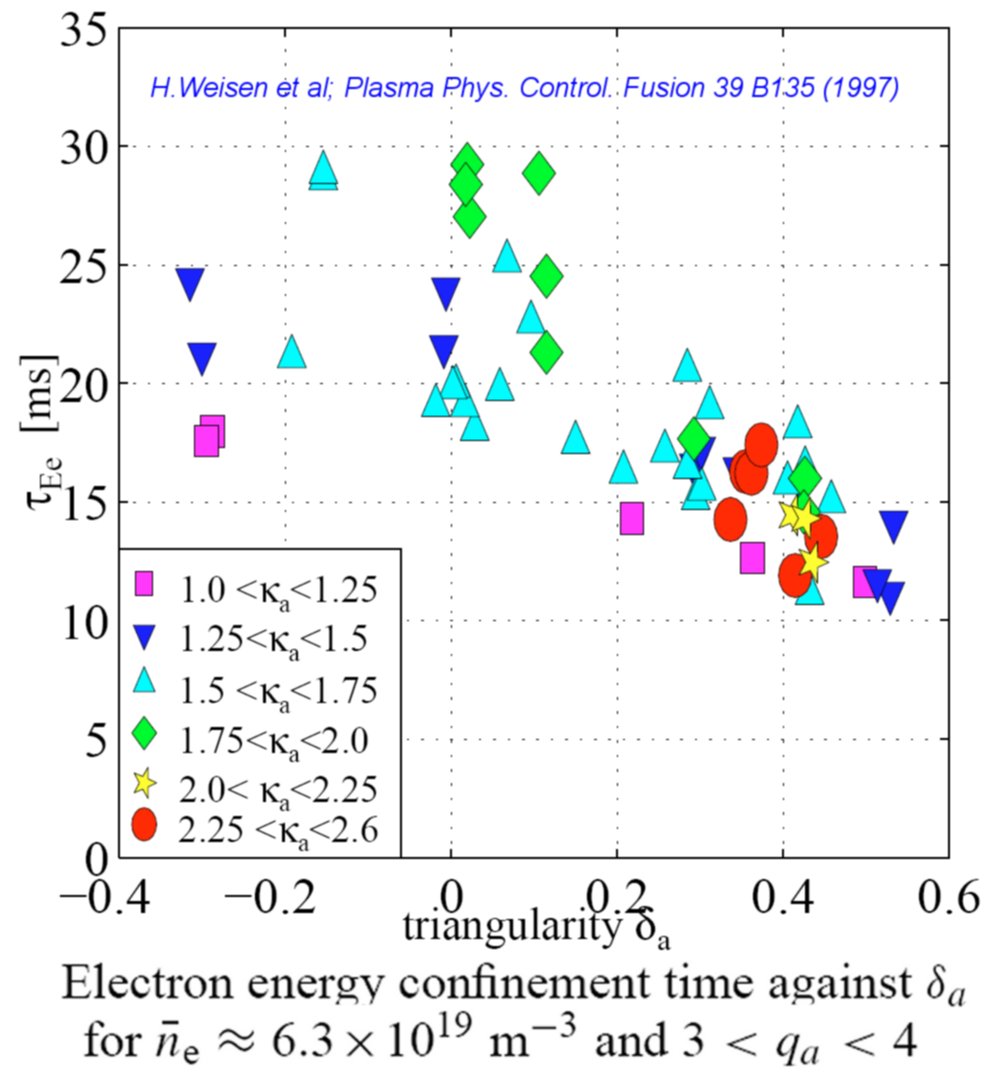 In limiter configuration in ohmic L-mode plasma, the energy confinement improves as the plasma triangularity is reduced and/or as the elongation is increased.
In limiter configuration in ohmic L-mode plasma, the energy confinement improves as the plasma triangularity is reduced and/or as the elongation is increased.- Over the broad range of positive and negative triangularities investigated, the electron heat diffusivity is observed to decrease with decreasing plasma triangularity, leading to a strong increase of plasma confinement at negative triangularity.
- Electron heat transport experiments in L-mode discharges at various plasma triangularities with radially localized ECH shows that electron heat diffusivity χe decreases with increasing collisionality and saturates at high values.
- Scenarios with different electron cyclotron heating power profile distributions and widths were compared in experiments on the TCV; the energy confinement properties of discharges with localized on-axis heating and distributed on-axis heating were very similar, with degradation close to that predicted by the ITER L-mode scaling; in the case of off-axis heating the confinement degradation was even stronger.
- The centrally deposited ECH and ECCD causes inverted sawteeth of the central density in sawtoothing discharges and leads to stationary hollow profiles in the absence of sawteeth (“density pumpout” phenomenon), it can be suppressed by stabilizing the mode by means of operation at high triangularity.
- The impurity transport has been investigated from injection of laser ablated non-recycling silicon; the impurity confinement can be remarkably different from that of energy. The ratio of impurity to energy confinement time ranges from near unity in Ohmic discharges to 5 in the presence of high power ECCD.
Recent activity on Transport
- Identification of the physical nature for current transport scaling and the profile stiffness in L-mode with improved edge Thomson measurements.
- Study of effect of EC power distribution on confinement near the density limit and on the value of the density limit.
- Investigation of influence of plasma shaping on pedestal parameters and ELMs in H-mode.
- Experimental study of turbulence and impurity transport in eITBs.
References
- N.A.Kirneva et al; Dependence of L-mode confinement on the electron cyclotron power deposition profile in the TCV tokamak; Plasma Physics and Controlled Fusion 54 015011 (2012), DOI:10.1088/0741-3335/54/1/015011
- Y.Camenen et al; Electron heat transport in shaped TCV L-mode plasmas; Plasma Physics and Controlled Fusion, 47(11) 1971 (2005) DOI:10.1088/0741-3335/47/11/007
- E.Scavino, J.Bakos, H.Weisen and TCV Team; Effects of ECRH power and safety factor on laser blow-off injected impurity confinement in TCV; Plasma Phys. Control. Fusion 46 857 (2004) doi:10.1088/0741-3335/46/5/008
- I.Furno and H. Weisen; Observation of inward and outward particle convection in the core of electron cyclotron heated and current driven plasmas in the Tokamak a Configuration Variable; Phys. Plasmas 10, 2422 (2003); DOI:10.1063/1.1576389
- E.Scavino, J.S.Bakos, R.Dux, H.Weisen and TCV Team; Effects of plasma shape on laser blow-off injected impurity transport in TCV; Plasma Phys. Control. Fusion 45 1961 (2003) DOI:10.1088/0741-3335/45/11/002
- H.Weisen et al; Shape dependence of sawtooth inversion radii and profile peaking factors in TCV L mode plasmas; Nucl. Fusion 42 136 (2002) DOI:10.1088/0029-5515/42/2/303
- H.Weisen, I.Furno and TCV Team; Particle transport with high power central ECH and ECCD in TCV; Nucl. Fusion 41 1227 (2001) DOI:10.1088/0029-5515/41/9/311
- H.Weisen, R.Behn, I.Furno, J.-M.Moret, and O.Sauter; “Profile consistency” features in strongly shaped Ohmic tokamak plasmas; Phys. Plasmas 6, 1 (1999); DOI:10.1063/1.873712
- H.Weisen et al; Effect of plasma shape on confinement and MHD behaviour in TCV; Plasma Phys. Control. Fusion 39 B135 (1997) DOI:10.1088/0741-3335/39/12B/011
- H.Weisen et al; Effect of plasma shape on confinement and MHD behaviour in the TCV tokamak; Nucl. Fusion 37 1741 (1997) doi:10.1088/0029-5515/37/12/I07
PhD theses
- M.Maslov, H.Weisen (Dir.); Particle transport in JET and TCV H-mode plasmas; EPFL, Lausanne, 2009. DOI:10.5075/epfl-thesis-4450
- Y.Camenen, A.Pochelon (Dir.); Étude du transport d’énergie thermique dans les plasmas du tokamak à configuration variable au moyen de chauffage électronique cyclotronique; EPFL, Lausanne, 2006. DOI:10.5075/epfl-thesis-3618
- A.Zabolotskiy, H.Weisen (Dir.); Particle transport in tokamak plasmas; EPFL, Lausanne, 2005. DOI:10.5075/epfl-thesis-3252
- P.Nikkola, O.Sauter (Dir.); The effect of electron transport on electron cyclotron current drive in tokamak plasmas; EPFL, Lausanne, 2004. DOI:10.5075/epfl-thesis-3048
- E.Scavino, H.Weisen (Dir.); Transport of laser-ablated impurities in the TCV tokamak; EPFL, Lausanne, 2002. DOI:10.5075/epfl-thesis-2677
- C.Angioni, O. Sauter (Dir.); Modelling of electron transport and of sawtooth activity in tokamaks; EPFL, Lausanne, 2001. DOI:10.5075/epfl-thesis-2469
- I.Furno, H.Weisen (Dir.); Fast transient transport phenomena measured by soft x-ray emission in TCV tokamak plasmas; EPFL, Lausanne, 2001. DOI:10.5075/epfl-thesis-2434
Key group members
External collaboration
- Natalia Kirneva Institute of Physics of Tokamaks, National Research Center “Kurchatov Institute”, Russia